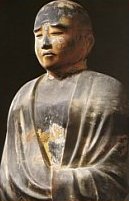|
The highest goal of Mahayana practitioners is to become a Bodhisattva (Sanskrit). The equivalent Japanese term is Bosatsu. Those who attain the enlightened Bosatsu stage will certainly achieve Buddhahood, but for a time they renounce this ultimate state, vowing to remain on earth in various guises (reincarnations) to help all living beings achieve salvation.

Bodhisattva 菩薩
Dated +1224, Daiho-on-ji Temple, Kyoto
Whereas Theravada stresses the monastic life -- the monk's life -- as the sole path to salvation (Arhatship), the Mahayana school says anyone, including laity, can attain enlightenment by practicing the Bodhisattva values. The Mahayana tradition thus includes numerous Bodhisattva saviors. It also includes numerous Buddha, with the Historical Buddha considered just one among many other Buddha.
Finally, the Bodhisattva concept was vigorously promoted and politicized by Mahayana adherents to differentiate it from the Theravada concept of Arhat. The Arhat is also an enlightened being, but according to Mahayana believers, the Arhat possesses an inferior, selfishly attained enlightenment, one based on "benefitting self." In contrast, the Bodhisattva are motivated entirely by compassion, by the desire to "benefit others."
|
The highest goal of a Theravadin is to become an Arhat (Sanskrit), or perfected saint. The equivalent Japanese term is Rakan or Arakan. The first disciples of Shaka Nyorai (Historical Buddha) all achieved enlightenment, and became known as the Arhats. In many traditions, they were asked by Shaka to remain in the world to propagate Buddhist law (dharma). Like the Bodhisattva, the Arhat will certainly achieve Buddhahood.

Arhat 羅漢
Dated +734, Kofukuji Temple, Nara
In Theravada traditions, only those who practice the meditative monastic life (i.e., the monks) can attain spiritual perfection. Enlightenment is not thought possible for those living the secular life.
Theravadins revere the Historical Buddha, but they do not pay homage to the numerous other Buddha and Bodhisattva worshiped by Mahayana followers.
Those who attain Arhatship have "slain" their greed, anger and delusions, and "destroyed" their karmic residue from previous lives. They have learned the teachings of Shaka Nyorai (Historical Buddha), earned the title of Mugaku (lit. = "nothing else to learn") and achieved the highest state attainable by Shaka's disciples.
The Arhat (and Bodhisattva as well) are no longer reborn into the world of suffering, no longer trapped in the cycle of samsara (the cycle of rebirth and redeath, the six states of existence).
|